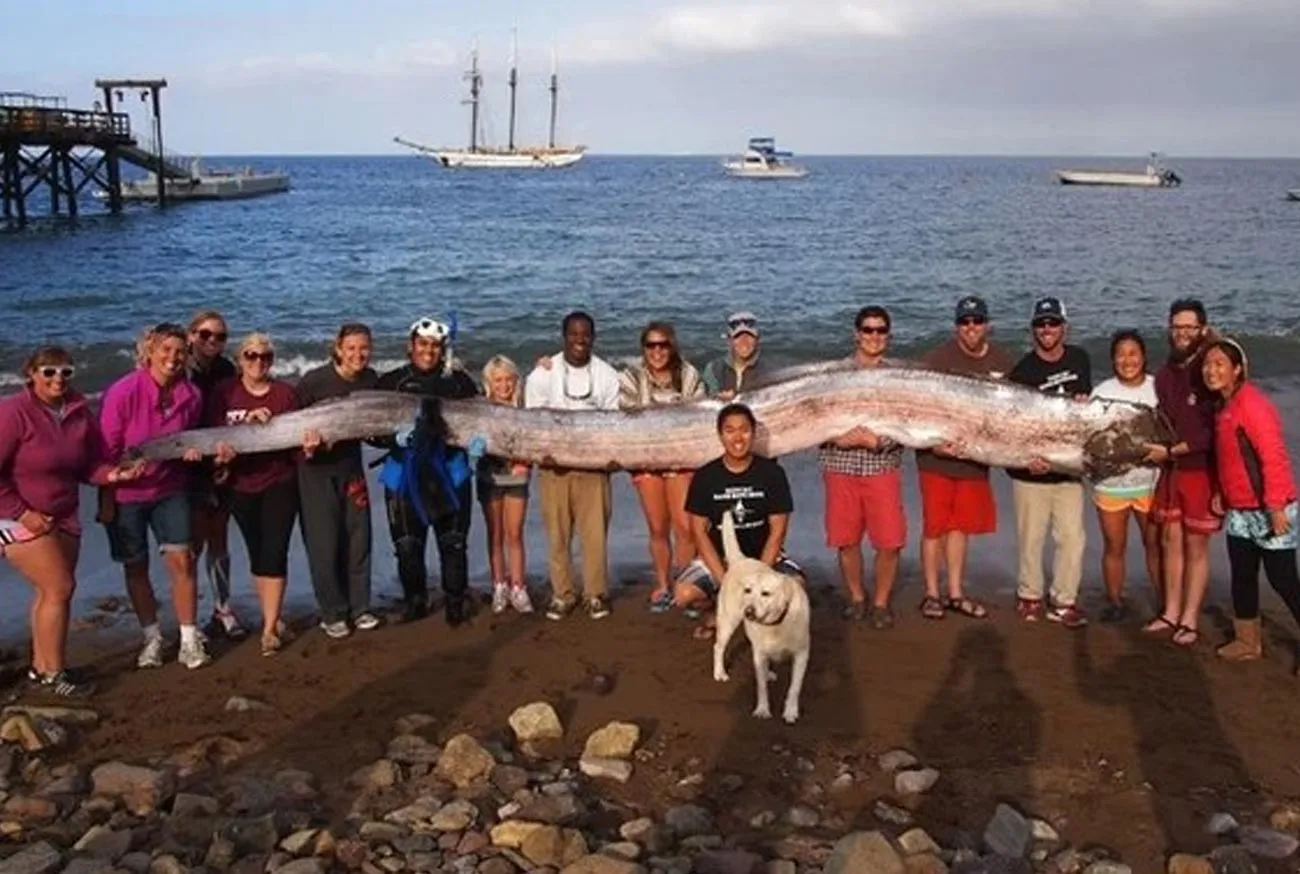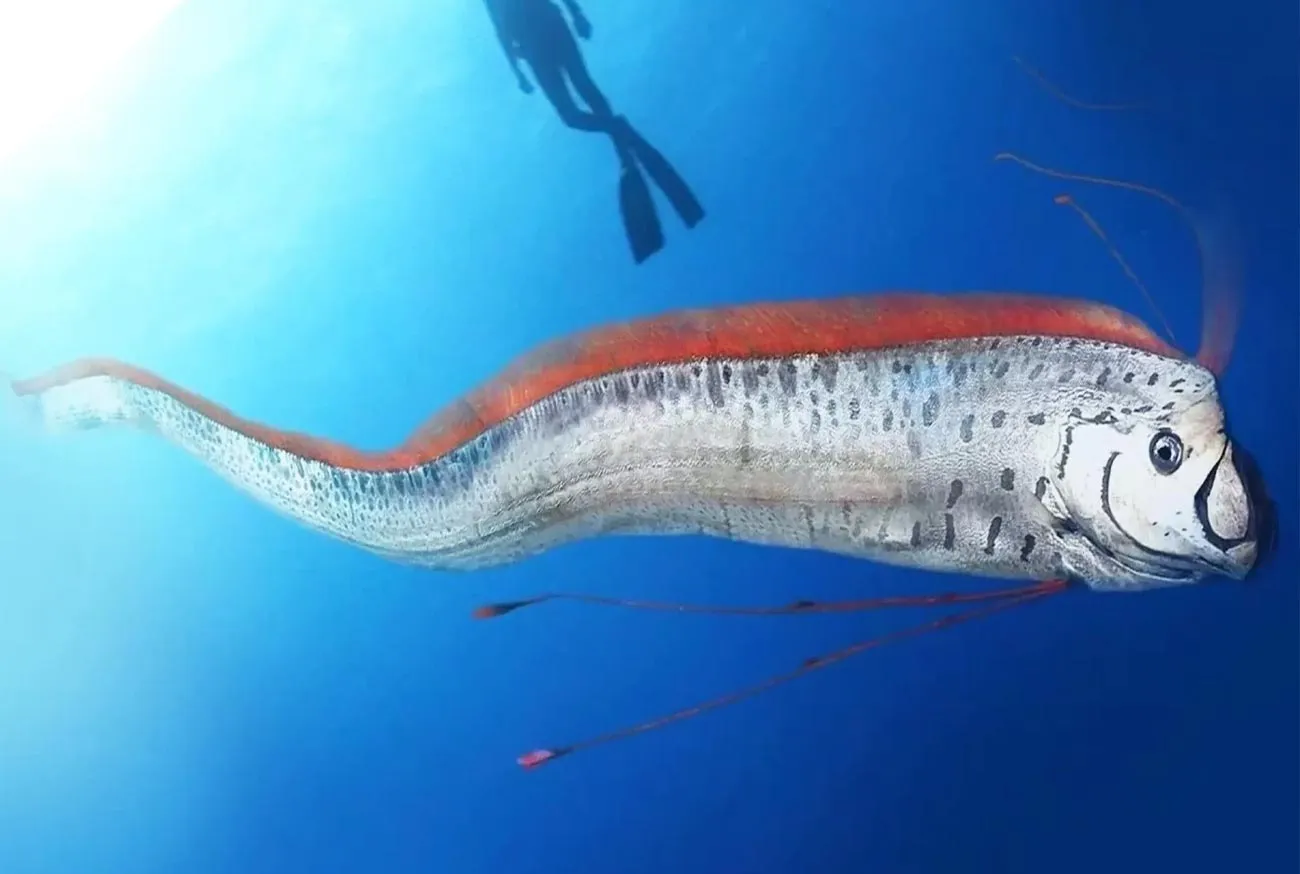What is the Oarfish?
The Oarfish (genus Regalecus), also known as the king of herrings, is an abyssal fish that inhabits depths between 200 and 1000 meters. Its body can reach an impressive 11 meters in length, making it the longest bony fish in the world.
📌 Main characteristics of the Oarfish:
✔️ Elongated, flattened body, resembling a ribbon
✔️ Shiny silver color with metallic reflections
✔️ Red dorsal fin that runs along the entire length of the body
✔️ Slow, undulating movement, giving it a "ghostly" appearance
Unlike sharks or other sea giants, the Oarfish is not an aggressive predator. It feeds on plankton, small crustaceans, and squid, using its small, toothless mouth.
But if it’s so harmless, why does it carry the fame of being the messenger of the apocalypse?

The fish of the end of the world: where does this belief come from?
The legend that the Oarfish announces natural disasters mainly comes from Japan, where it is called "Ryugu no tsukai", or "Messenger of the Dragon Palace". According to Japanese folklore, whenever a Oarfish is found on the surface or stranded on the beach, a tsunami or earthquake might be on the way.
This belief became even more popular after the devastating 2011 tsunami in Japan. Just before the tragedy, several were found dead on the beaches, which reinforced the idea that they can predict natural catastrophes.
But is there a scientific explanation for this?
Does the oarfish really predict earthquakes?
Science still doesn't have a definitive answer to this question, but some theories try to explain the relationship between oarfish and natural disasters:
🔹 Sensitivity to seismic changes: Since they live in great depths, oarfish may be more sensitive to seismic and magnetic changes at the ocean floor. Tectonic movements could affect their behavior, causing them to surface.
🔹 Changes in water temperature: Underwater volcanic activity and seismic movements can alter the temperature and chemical composition of the water, forcing the oarfish to seek less hostile waters.
🔹 Unrelated natural phenomena: Another possibility is that sightings of oarfish occur by coincidence with earthquakes and tsunamis, without a direct connection. After all, the oceans are vast, and these fish can surface for various natural reasons.
Despite these theories, there is no scientific proof that the oarfish is a "natural alarm" for disasters. But the doubt remains, and whenever one of them appears, concern spreads!
Surprising Facts
🐟 The largest bony fish in the world: While whales and sharks are cartilaginous fish, the oarfish is the largest fish with a bony skeleton ever recorded.
🌊 No one has ever seen a healthy oarfish swimming in its natural habitat! Since they live at extreme depths, nearly all observations happen when they appear already weakened or dead at the surface.
🦑 Inspiration for sea monster legends: Many ancient reports about sea serpents could have actually been sightings of oarfish gliding through the waters.
📍 Records from around the world: Although more common in Japan and the Pacific, oarfish have been found in various parts of the world, including Brazil, Mexico, and the United States.
🌍 Little studied and full of mysteries: Since they live in hard-to-reach areas, much about oarfish is still unknown. Researchers continue to try to better understand their ecology and behavior.

Can the Oarfish be kept as a pet?
If you're wondering if the oarfish can be a pet, the answer is no. Besides its gigantic size, it requires specific conditions of high pressure and deep waters to survive.
But for those who enjoy aquarium keeping, there are several options for exotic fish that can be kept at home, such as:
🐠 Goldfish – classic and charming
🐡 Ryukin Goldfish – graceful and easy to maintain
🐟 Oranda Goldfish – sophisticated and elegant
🦁 Lionhead Goldfish – impressive and majestic
If you're passionate about the aquatic world, you can invest in a themed aquarium and learn more about marine life without needing a giant fish swimming in your living room!
Mystery or Superstition?
Undoubtedly one of the most mysterious creatures of the ocean. Its unique appearance and its habit of emerging at unexpected moments fuel both legends and scientific investigations.
Whether a harbinger of the end of the world or simply a victim of natural forces, the oarfish continues to fascinate and spark curiosity among researchers and marine life enthusiasts.
💬 What do you think? Can the oarfish really predict natural disasters, or is it just a coincidence? Leave your opinion in the comments!
If you liked this article, share it with your friends who are passionate about ocean mysteries! 🌊🐟
People also ask
Why is the oarfish called the fish of the end of the world?
He earned this nickname because it is associated with legends and superstitions, particularly in Japan, where it is seen as a sign of earthquakes and tsunamis. Its long, serpentine appearance, as well as its habit of appearing dead on the surface before major natural disasters, reinforces the myth that it heralds the "end of the world."
Is there an oarfish in Brazil?
Yes! The oarfish has been recorded in Brazilian waters, especially along the Atlantic coast. While it is more common in Japan and the Pacific Ocean, its distribution is global, and it can be found in various parts of the world, including Brazil's coastline.
Where does the oarfish live?
The oarfish inhabits deep waters, between 200 and 1000 meters deep, where sunlight barely reaches. It prefers abyssal seas and rarely comes to the surface, being seen only when sick, dying, or after storms that bring it to shallower waters.
Can you eat the oarfish?
Although technically an edible fish, the oarfish is not consumed due to its gelatinous and flavorless meat. Additionally, because it lives at great depths, it may accumulate toxins, making its consumption potentially risky.

















Add comment